Abstract
This paper describes a model of successful immunotherapy of advanced lymphoma based on the selective elimination of cycling tumour-induced suppressor T cells. It shows that a single injection of the anti-mitotic drug, vinblasting (Vb), results in complete regression of a large L5178Y lymphoma and its metastases, but not if it is growing in an immunocompetent host. Vb-induced, immunologically mediated tumour regression was dependent on the anti-tumour function of CD8+ T cells, because regression was prevented by depleting the host of this subset of T cells 24 hr after Vb was given. Regression was also prevented by infusing the host with Vb-sensitive, CD4+ T cells from a tumour-bearing donor. These and other results are in keeping with the interpretation that Vb-induced regression of the L5178Y lymphoma depends on the ability of the drug to eliminate CD4+ suppressor T cells that are replicating, and to spare non-replicating CD8+ effector cells. It is suggested that at an advanced stage of growth of the L5178Y lymphoma the host possesses an acquired population of antigen-primed CD8+ effector T cells that are unable to become activated in response to abundant tumour antigen because of the dominant influence of CD4+ suppressor cells. Activation of these CD8+ T cells was indicated by the finding that they were rapidly converted from being cyclophosphamide (Cy) resistant to being highly Cy sensitive within 48 hr of giving Vb.
Full text
PDF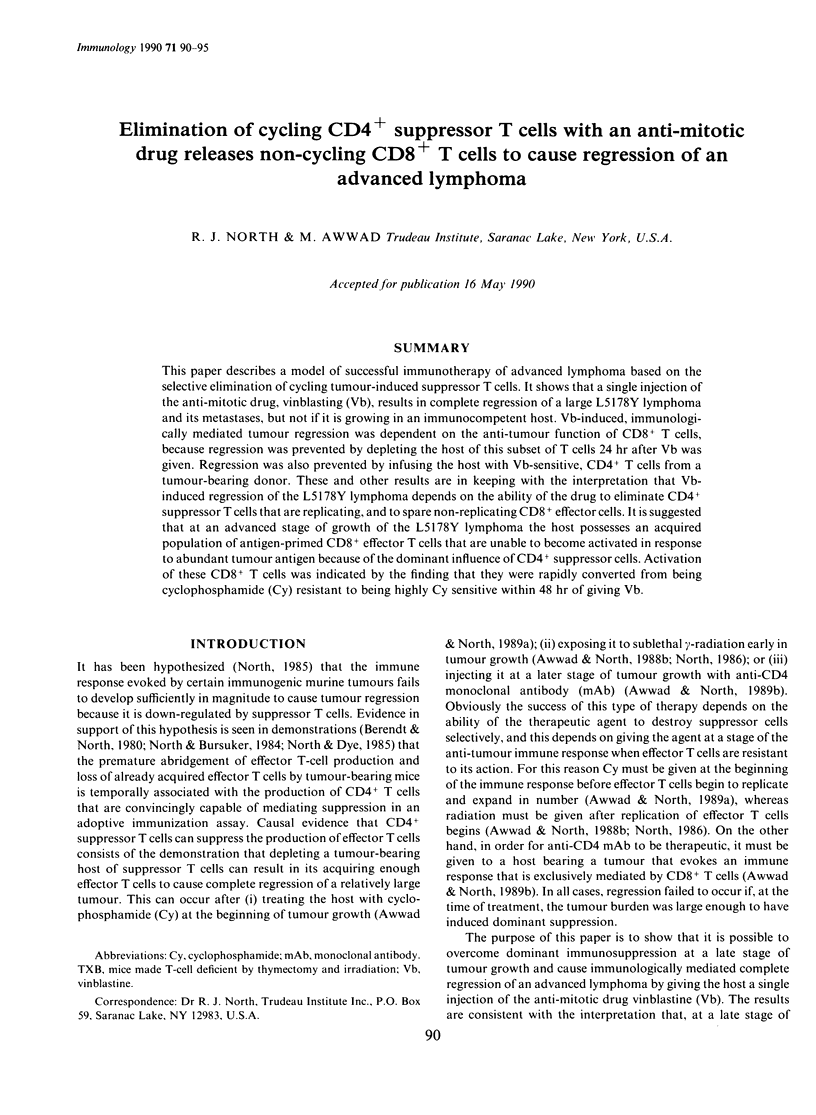
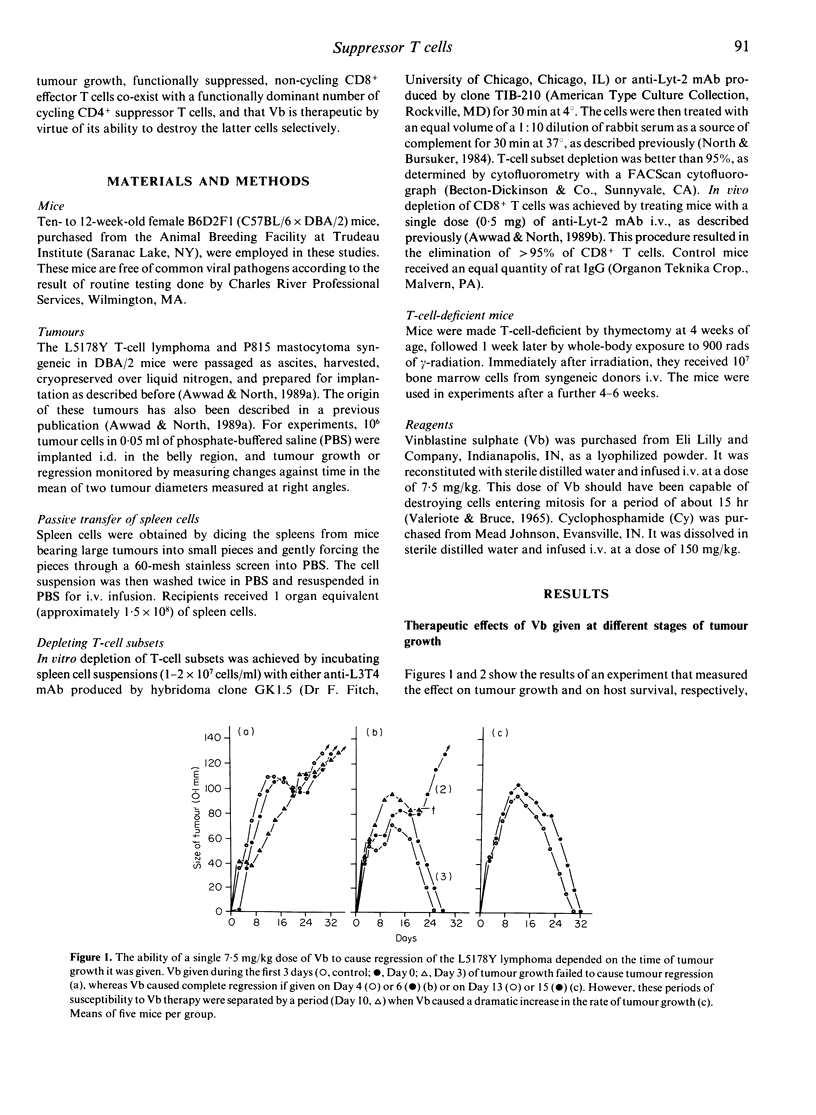
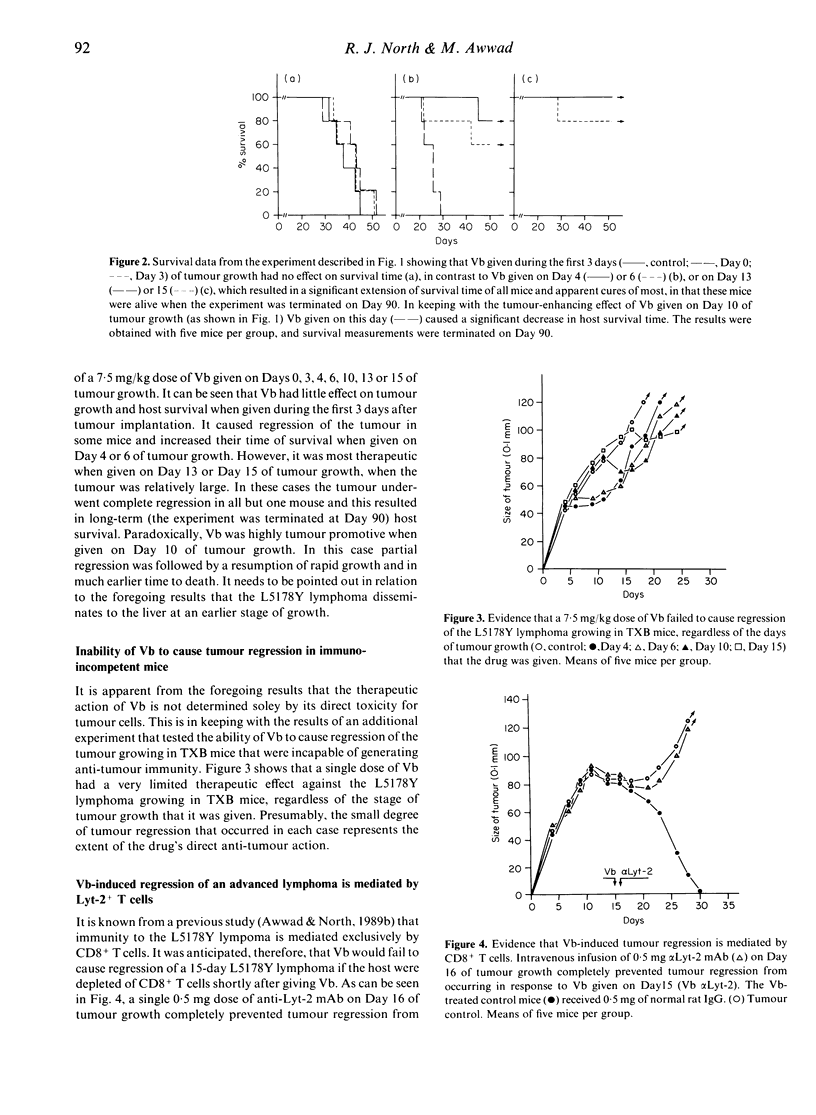
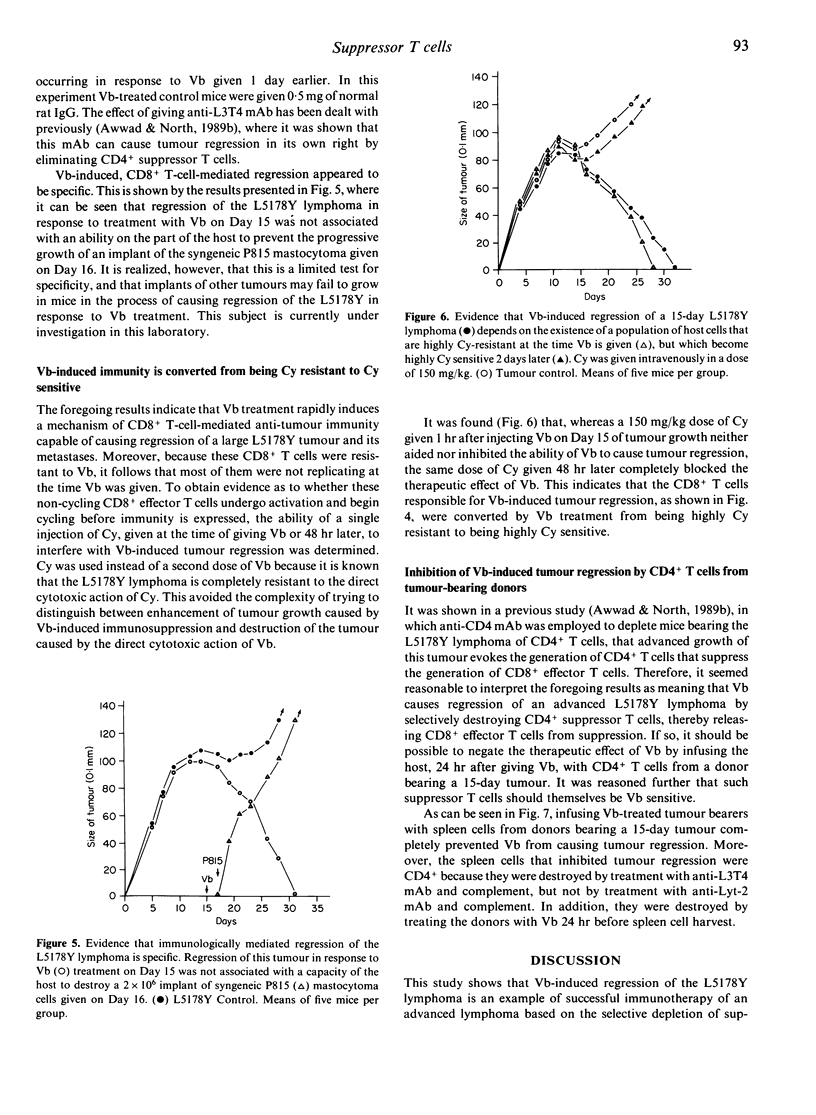
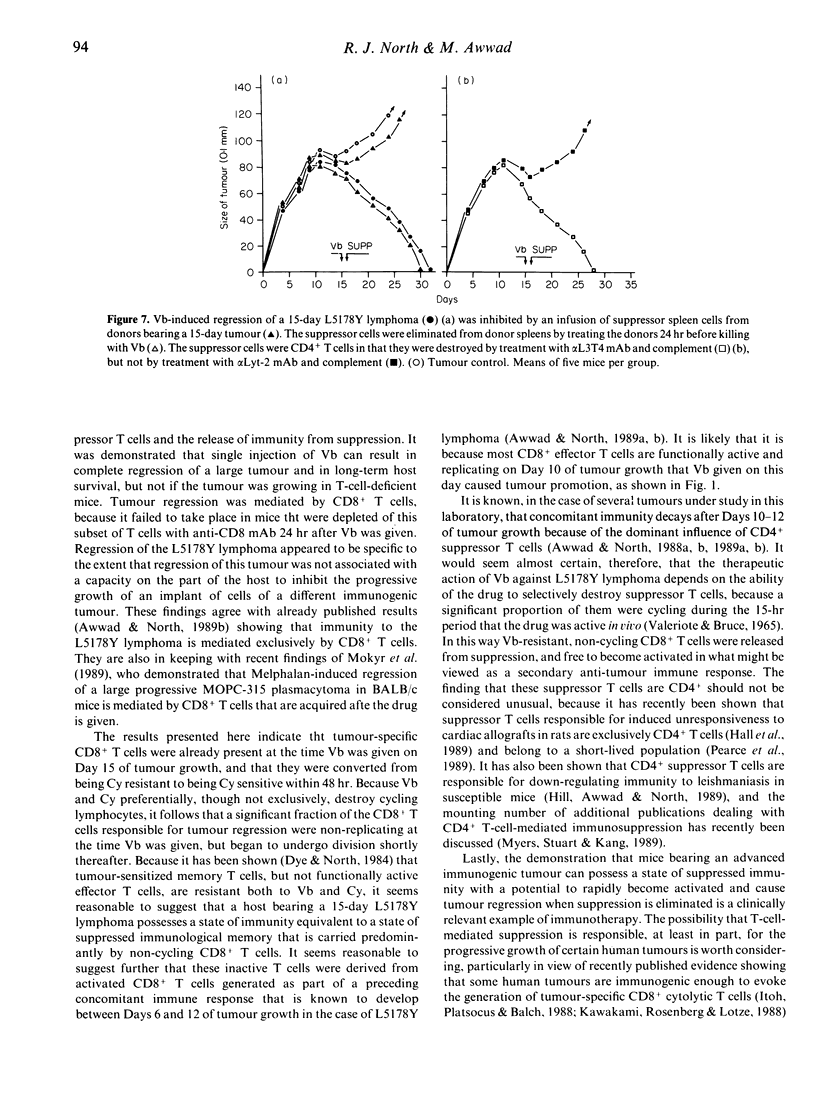
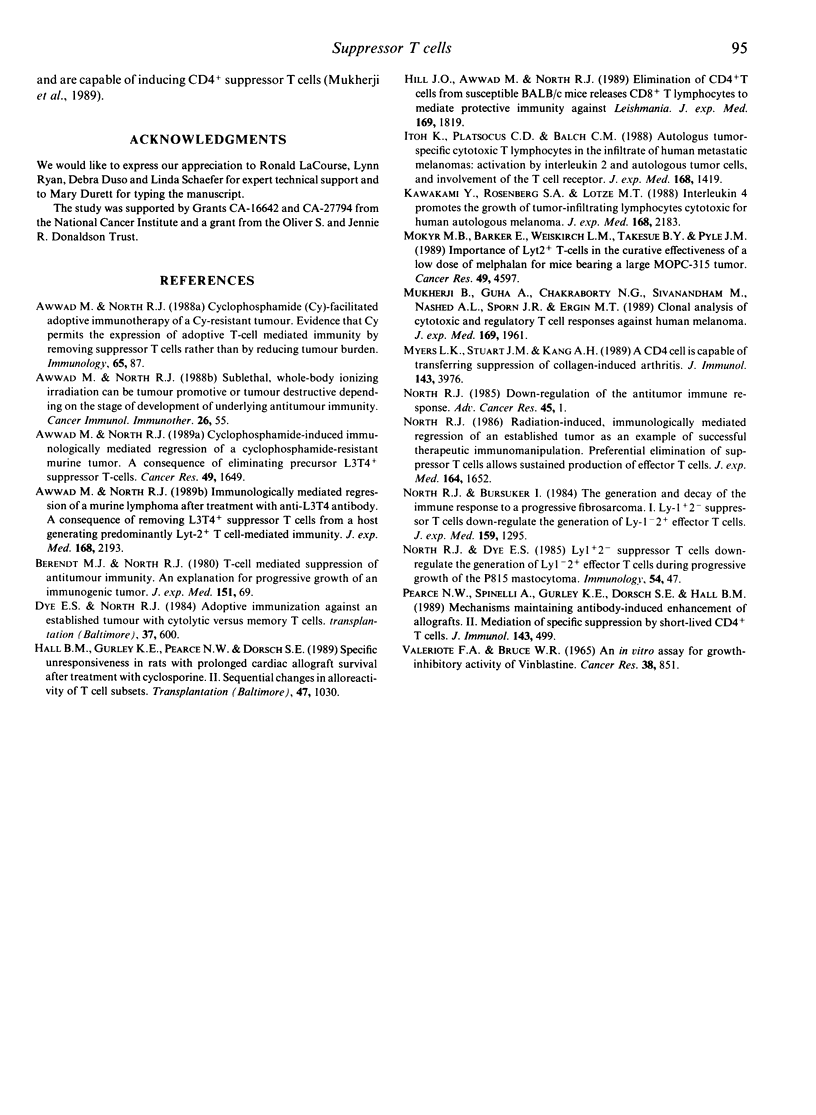
Selected References
These references are in PubMed. This may not be the complete list of references from this article.
- Awwad M., North R. J. Cyclophosphamide-induced immunologically mediated regression of a cyclophosphamide-resistant murine tumor: a consequence of eliminating precursor L3T4+ suppressor T-cells. Cancer Res. 1989 Apr 1;49(7):1649–1654. [PubMed] [Google Scholar]
- Awwad M., North R. J. Immunologically mediated regression of a murine lymphoma after treatment with anti-L3T4 antibody. A consequence of removing L3T4+ suppressor T cells from a host generating predominantly Lyt-2+ T cell-mediated immunity. J Exp Med. 1988 Dec 1;168(6):2193–2206. doi: 10.1084/jem.168.6.2193. [DOI] [PMC free article] [PubMed] [Google Scholar]
- Awwad M., North R. J. Sublethal, whole-body ionizing irradiation can be tumor promotive or tumor destructive depending on the stage of development of underlying antitumor immunity. Cancer Immunol Immunother. 1988;26(1):55–60. doi: 10.1007/BF00199848. [DOI] [PMC free article] [PubMed] [Google Scholar]
- Berendt M. J., North R. J. T-cell-mediated suppression of anti-tumor immunity. An explanation for progressive growth of an immunogenic tumor. J Exp Med. 1980 Jan 1;151(1):69–80. doi: 10.1084/jem.151.1.69. [DOI] [PMC free article] [PubMed] [Google Scholar]
- Dye E. S., North R. J. Adoptive immunization against an established tumor with cytolytic versus memory T cells. Immediate versus delayed onset of regression. Transplantation. 1984 Jun;37(6):600–605. doi: 10.1097/00007890-198406000-00015. [DOI] [PubMed] [Google Scholar]
- Hall B. M., Gurley K. E., Pearce N. W., Dorsch S. E. Specific unresponsiveness in rats with prolonged cardiac allograft survival after treatment with cyclosporine. II. Sequential changes in alloreactivity of T cell subsets. Transplantation. 1989 Jun;47(6):1030–1033. doi: 10.1097/00007890-198906000-00022. [DOI] [PubMed] [Google Scholar]
- Hill J. O., Awwad M., North R. J. Elimination of CD4+ suppressor T cells from susceptible BALB/c mice releases CD8+ T lymphocytes to mediate protective immunity against Leishmania. J Exp Med. 1989 May 1;169(5):1819–1827. doi: 10.1084/jem.169.5.1819. [DOI] [PMC free article] [PubMed] [Google Scholar]
- Itoh K., Platsoucas C. D., Balch C. M. Autologous tumor-specific cytotoxic T lymphocytes in the infiltrate of human metastatic melanomas. Activation by interleukin 2 and autologous tumor cells, and involvement of the T cell receptor. J Exp Med. 1988 Oct 1;168(4):1419–1441. doi: 10.1084/jem.168.4.1419. [DOI] [PMC free article] [PubMed] [Google Scholar]
- Kawakami Y., Rosenberg S. A., Lotze M. T. Interleukin 4 promotes the growth of tumor-infiltrating lymphocytes cytotoxic for human autologous melanoma. J Exp Med. 1988 Dec 1;168(6):2183–2191. doi: 10.1084/jem.168.6.2183. [DOI] [PMC free article] [PubMed] [Google Scholar]
- Mokyr M. B., Barker E., Weiskirch L. M., Takesue B. Y., Pyle J. M. Importance of Lyt 2+ T-cells in the curative effectiveness of a low dose of melphalan for mice bearing a large MOPC-315 tumor. Cancer Res. 1989 Aug 15;49(16):4597–4606. [PubMed] [Google Scholar]
- Mukherji B., Guha A., Chakraborty N. G., Sivanandham M., Nashed A. L., Sporn J. R., Ergin M. T. Clonal analysis of cytotoxic and regulatory T cell responses against human melanoma. J Exp Med. 1989 Jun 1;169(6):1961–1976. doi: 10.1084/jem.169.6.1961. [DOI] [PMC free article] [PubMed] [Google Scholar]
- Myers L. K., Stuart J. M., Kang A. H. A CD4 cell is capable of transferring suppression of collagen-induced arthritis. J Immunol. 1989 Dec 15;143(12):3976–3980. [PubMed] [Google Scholar]
- North R. J., Bursuker I. Generation and decay of the immune response to a progressive fibrosarcoma. I. Ly-1+2- suppressor T cells down-regulate the generation of Ly-1-2+ effector T cells. J Exp Med. 1984 May 1;159(5):1295–1311. doi: 10.1084/jem.159.5.1295. [DOI] [PMC free article] [PubMed] [Google Scholar]
- North R. J. Down-regulation of the antitumor immune response. Adv Cancer Res. 1985;45:1–43. doi: 10.1016/s0065-230x(08)60265-1. [DOI] [PubMed] [Google Scholar]
- North R. J. Radiation-induced, immunologically mediated regression of an established tumor as an example of successful therapeutic immunomanipulation. Preferential elimination of suppressor T cells allows sustained production of effector T cells. J Exp Med. 1986 Nov 1;164(5):1652–1666. doi: 10.1084/jem.164.5.1652. [DOI] [PMC free article] [PubMed] [Google Scholar]
- Pearce N. W., Spinelli A., Gurley K. E., Dorsch S. E., Hall B. M. Mechanisms maintaining antibody-induced enhancement of allografts. II. Mediation of specific suppression by short lived CD4+ T cells. J Immunol. 1989 Jul 15;143(2):499–506. [PubMed] [Google Scholar]
- Valeriote F. A., Bruce W. R. An in vitro assay for growth-inhibiting activity of vinblastine. J Natl Cancer Inst. 1965 Nov;35(5):851–856. [PubMed] [Google Scholar]


